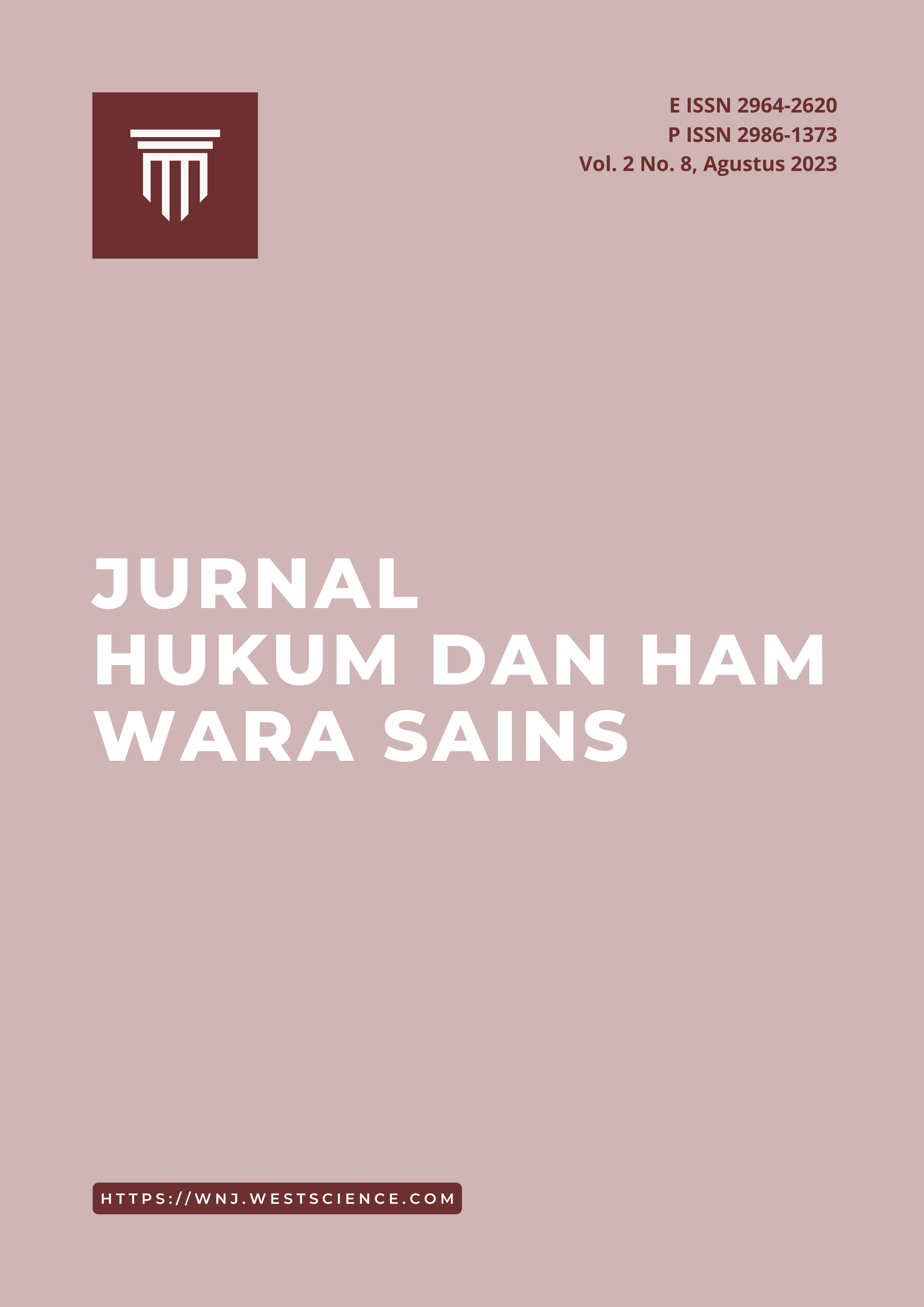Inovasi dalam Advokasi Hak Asasi Manusia: Strategi dan Pendekatan Hukum
DOI:
https://doi.org/10.58812/jhhws.v2i08.606Kata Kunci:
Inovasi, Hak Asasi Manusia, Advokasi, Hukum, Strategi, BibliometrikAbstrak
Inovasi dalam advokasi hak asasi manusia telah menjadi katalisator untuk mengatasi tantangan-tantangan yang kompleks dan memajukan keadilan dalam skala global. Makalah penelitian ini menggali ranah strategi dan pendekatan hukum yang inovatif yang telah membentuk lanskap advokasi hak asasi manusia. Menggabungkan analisis bibliometrik kuantitatif dengan wawasan kualitatif dari wawancara ahli dan studi kasus, kami mengungkap interaksi yang rumit antara tradisi dan inovasi. Analisis ini mengungkap munculnya kelompok-kelompok tematik, jaringan kolaboratif, dan aktor-aktor berpengaruh yang menentukan lanskap inovasi. Temuan kami menggarisbawahi pentingnya adaptasi kontekstual, pertimbangan etika, dan sifat kolaboratif inovasi dalam mendorong perubahan yang berarti. Dengan mengintegrasikan analisis empiris dengan perspektif dunia nyata, penelitian ini berkontribusi pada pemahaman kita tentang peran dinamis dan transformatif yang dimainkan oleh inovasi dalam menegakkan prinsip-prinsip keadilan, kesetaraan, dan martabat manusia.
Referensi
Assembly, U. N. G. (1948). Universal declaration of human rights. UN General Assembly, 302(2), 14–25.
Buerger, C. (2021). Human rights hackers: crafting advocacy in Accra, Ghana. The Journal of Legal Pluralism and Unofficial Law, 53(2), 206–226.
Chen, M. (2023). Radical Defence: The American Committee for Protection of Foreign Born and the Movement for Deportation Resistance and Immigrants’ Rights. Journal of Migration History, 9(1), 106–134.
Davenport, T. H. (1993). Process innovation: reengineering work through information technology. Harvard Business Press.
Dutt, M., & Rasul, N. (2014). Raising digital consciousness: An analysis of the opportunities and risks facing human rights activists in a digital age. SUR-Int’l J. on Hum Rts., 11, 427.
Eaton, J. P. (2017). The Nigerian tragedy, environmental regulation of transnational corporations, and the human right to a healthy environment. In International Crimes (pp. 407–453). Routledge.
Fallah, D. G. (2019). Assessing Strategic Litigation Impact on Human Rights. SciELO Brasil.
Fung, A., & Wright, E. O. (2001). Deepening democracy: Innovations in empowered participatory governance. Politics & Society, 29(1), 5–41.
Geels, F. W. (2004). From sectoral systems of innovation to socio-technical systems: Insights about dynamics and change from sociology and institutional theory. Research Policy, 33(6–7), 897–920.
Heinzelman, J., & Meier, P. (2015). Crowdsourcing for human rights monitoring: Challenges and opportunities for information collection and verification. Human Rights and Ethics: Concepts, Methodologies, Tools, and Applications, 409–424.
Iskandar, Y., Joeliaty, J., Kaltum, U., & Hilmiana, H. (2021). Bibliometric Analysis on Social Entrepreneurship Specialized Journals. Journal: WSEAS TRANSACTIONS ON ENVIRONMENT AND DEVELOPMENT, 941–951.
Jaman, U. B. (2023). Legal Analysis of The Impact of Industrial Development on The Environment. The Easta Journal Law and Human Rights, 1(03), 87–92.
Jaman, U. B., Putri, G. R., & Anzani, T. A. (2021). Urgensi Perlindungan Hukum Terhadap Hak Cipta Karya Digital. Jurnal Rechten: Riset Hukum Dan Hak Asasi Manusia, 3(1), 9–17.
Keck, M. E., & Sikkink, K. (1998). Activists beyond borders: Advocacy networks in international politics. Cornell University Press.
Kubota, Y. (1987). Consideration of the Relationship Between Scientific and Technological Developments and Human Rights in the United Nations Human Rights Fora. Nordic J. Int’l L., 56, 334.
Livingstone, S., & Third, A. (2017). Children and young people’s rights in the digital age: An emerging agenda. In New media & society (Vol. 19, Issue 5, pp. 657–670). Sage Publications Sage UK: London, England.
McPherson, E. (2015). ICTs and human rights practice. CGHR, Dept. of Politics and International Studies, University of Cambridge. DOI: Https://Www. Repository. Cam. Ac. Uk/Handle/1810/251346.
Moyn, S. (2012). The last utopia: human rights in history. Harvard University Press.
Ogunwale, A., Fadipe, B., & Bifarin, O. (2023). Indigenous mental healthcare and human rights abuses in Nigeria: The role of cultural syntonicity and stigmatization. Frontiers in Public Health, 11, 1122396.
Park, B., Murdie, A., & Davis, D. R. (2019). The (co) evolution of human rights advocacy: Understanding human rights issue emergence over time. Cooperation and Conflict, 54(3), 313–334.
Porter, M. E., & Kramer, M. R. (2018). Creating shared value: How to reinvent capitalism—And unleash a wave of innovation and growth. In Managing sustainable business: An executive education case and textbook (pp. 323–346). Springer.
Puvimanasinghe, S. (2004). Public Interest Litigation, Human Rights and the Environment in the Experience of Sri Lanka. In International Law and Sustainable Development (pp. 653–676). Brill Nijhoff.
Sabatier, P. A., & Weible, C. M. (2019). The advocacy coalition framework: Innovations and clarifications. In Theories of the Policy Process, Second Edition (pp. 189–220). Routledge.
Soja, E. W. (2013). Seeking spatial justice (Vol. 16). U of Minnesota Press.
Tidd, J., & Bessant, J. R. (2020). Managing innovation: integrating technological, market and organizational change. John Wiley & Sons.
Unduhan
Diterbitkan
Cara Mengutip
Terbitan
Bagian
Lisensi
Hak Cipta (c) 2023 Sopian, Desmarani Helfisar

Artikel ini berlisensiCreative Commons Attribution-ShareAlike 4.0 International License.



















 Instagram
Instagram 